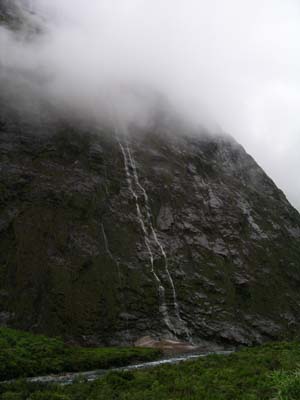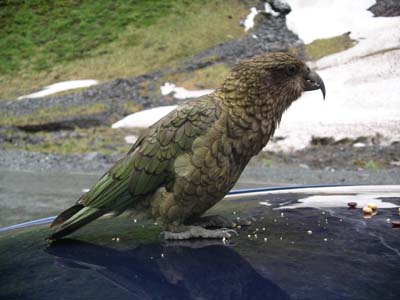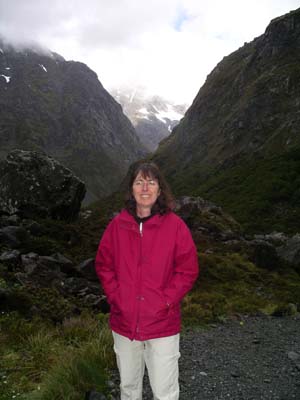Thursday, January 22 and Friday, January 23
Steve: We have now moved to Fiordland, with some of the most spectacular scenery that we've seen yet. Fiordland National Park is in the southwest corner of the South Island, and is famous for its rugged fiords, mountains, lakes and lush vegetation. It's also home to the Milford Track, one of the best-known walks in the world.
 On
Thursday, we left Wanaka and made the drive over the Cardrona Pass, down through
Queenstown and eventually to Manapouri. We had another great drive, highlighted
by our drive over the pass which was absolutely beautiful. The picturesque
road winds its way through mountains that rise steeply on both sides - we
were never able to
On
Thursday, we left Wanaka and made the drive over the Cardrona Pass, down through
Queenstown and eventually to Manapouri. We had another great drive, highlighted
by our drive over the pass which was absolutely beautiful. The picturesque
road winds its way through mountains that rise steeply on both sides - we
were never able to see more than a bit of road ahead of us. At the top of the pass we stopped
to take in the views, and then stopped several more times as we made our way
down toward Queenstown. The scenes with sheep lazily grazing in green pastures
framed by dramatic mountains were our favorites.
see more than a bit of road ahead of us. At the top of the pass we stopped
to take in the views, and then stopped several more times as we made our way
down toward Queenstown. The scenes with sheep lazily grazing in green pastures
framed by dramatic mountains were our favorites. 
We had been curious to see what Queenstown was like, since many people stay
there. From what we saw, the scenery is very similar to Wanaka, but the area
certainly looks much more developed. We know that Queenstown is more crowded,
so we're happy that we went to Wanaka instead. Lake Wakatipu is absolutely
huge, and Queenstown and its attractions only occupy a small part of the lake - we drove
right along the lake for a full 30 minutes admiring the deep blue water and
the huge cliffs that surround it. We saw no development or boats at all on
that part of the lake, and were happy to see so much beautiful land that has
been left undisturbed.
Queenstown and its attractions only occupy a small part of the lake - we drove
right along the lake for a full 30 minutes admiring the deep blue water and
the huge cliffs that surround it. We saw no development or boats at all on
that part of the lake, and were happy to see so much beautiful land that has
been left undisturbed.

Manapouri (located on a lake by the smae name) along with its larger sister
town of Te Anau, is considered to be the gateway to Fiordland, and its myriad
of activities for outdoor enthusiasts. There are all kinds of hikes (what
they call "tramps"), boat trips, kayak excursions, and helicopter
and airplane tours (Air Fiordland will fly you anywhere!). Some of the tracks,
like the Milford Track, require several days of hiking and have huts interspersed
along the way. 
We're staying at a guest house called Murrell's Grand View House, located
in Manapouri (population 205). This charming B&B was established in 1889,
and is run by Jack Murrell and his wife Klaske. Jack's family has been involved
in much  of
the original exploration of this area, including the discovery of the Wilmot
Pass that leads from Lake Manapouri to Doubtful Sound (our destination for
Saturday). Jack and Klaske are charming people, and we've enjoyed hearing
their stories about how this area was initially developed starting in the
1800's, and the role that Jack's family played. Murrell's Grand View House
only has 4 guest rooms, and all have great views of Lake Manapouri and the
mountains that surround it.
of
the original exploration of this area, including the discovery of the Wilmot
Pass that leads from Lake Manapouri to Doubtful Sound (our destination for
Saturday). Jack and Klaske are charming people, and we've enjoyed hearing
their stories about how this area was initially developed starting in the
1800's, and the role that Jack's family played. Murrell's Grand View House
only has 4 guest rooms, and all have great views of Lake Manapouri and the
mountains that surround it.
 After
arriving and settling in on Thursday afternoon, we walked down to Lake Manapouri
to enjoy the beautiful weather, relax by the shore, and cast our lines in
our never-ending hunt for fish. We were successful in the first two endeavors,
but despite seeing fish near our lures, we couldn't get any to bite. It didn't
matter too much, however, because we loved simply spending time alongside
this lake, referred to in some of our books as being one of the most beautiful
in all of New Zealand. During the evening we drove the 20 minutes to Te Anau
to explore the town and have dinner. Te Anau is also very nice, and has several
shops and restaurants that cater to the outdoor enthusiasts that stay here.
After
arriving and settling in on Thursday afternoon, we walked down to Lake Manapouri
to enjoy the beautiful weather, relax by the shore, and cast our lines in
our never-ending hunt for fish. We were successful in the first two endeavors,
but despite seeing fish near our lures, we couldn't get any to bite. It didn't
matter too much, however, because we loved simply spending time alongside
this lake, referred to in some of our books as being one of the most beautiful
in all of New Zealand. During the evening we drove the 20 minutes to Te Anau
to explore the town and have dinner. Te Anau is also very nice, and has several
shops and restaurants that cater to the outdoor enthusiasts that stay here.
On Friday we spent the day driving and exploring the 120 kilometer road that
leads to Milford Sound. This has to be one of the best drives we've ever done.
The Milford area gets over 220 inches of rain annually (there are only 160
days without rain each year), and the morning brought intermittent rain that
varied between light drizzle and heavy downpour. The rain created a wonderful
mysterious effect along the cliffs an d
mountains, with beautiful cloud formations that hung low in the valleys. At
times, the clouds would clear and we'd see various patches of blue sky allowing
us to catch momentary glimpses of the tops of the mountains and cliffs that
surrounded us.
d
mountains, with beautiful cloud formations that hung low in the valleys. At
times, the clouds would clear and we'd see various patches of blue sky allowing
us to catch momentary glimpses of the tops of the mountains and cliffs that
surrounded us.
We stopped several times to walk and explore the many lakes, streams, valleys
and nature trails that line the road. Gunn Lake was one of our favorites -
there's a short walk that leads into a forest that is absolutely covered in
thick moss of all shades of green. The moss is everywhere, growing up the
trunks of live trees and on the many dead branches along the ground. The forest
appears to have a lush green carpet that permeates everything. Combined with all the ferns and other moisture-loving plants, the color and feel of
this forest was unlike anything we've seen before - a very special place.
with all the ferns and other moisture-loving plants, the color and feel of
this forest was unlike anything we've seen before - a very special place.
We also found a small bay with calm water that was great for fishing. Again,
we saw several trout cruising along the surface, but none that would bite!
This didn't take too much away from our enjoyment, because this lake, like
all the others around here, is in a very beautiful setting. 
From Gunn Lake we continued our trip toward Milford and soon found ourselves
driving through gorges lined with huge cliffs and hundreds of waterfalls.
The water appeared to start in the clouds and crash down the vertical rock
faces toward the streams and rushing rivers below. At every turn, we saw new
waterfalls and we often found ourselves stopping just to watch and hear the
sound=s. At one spot, just before Homer tunnel, we took a short walk up to
a particularly be autiful
area with several waterfalls that careened into snow banks below.
autiful
area with several waterfalls that careened into snow banks below.
Homer tunnel was quite an adventure. It's about ½ mile long, and was
cut right through solid rock by several hundred workers from 1935-1953. The
tunnel is extraordinarily narrow, and has no lights inside. It's so dark that
the car headlights seem to not do anything - we thought they were broken (this
probably also resulted from the lack of time available for our eyes to acclimate).
We had heard about this during breakf ast
this morning from a couple that had just made this drive, but we didn't really
believe them until we experienced it ourselves. Fortunately, there was little
traffic, so we slowed to a crawl and nervously inched our way through. It's
scary to imagine what it would be like during rush of buses that we understand
make this drive each morning and return in the mid-afternoon.
ast
this morning from a couple that had just made this drive, but we didn't really
believe them until we experienced it ourselves. Fortunately, there was little
traffic, so we slowed to a crawl and nervously inched our way through. It's
scary to imagine what it would be like during rush of buses that we understand
make this drive each morning and return in the mid-afternoon.
We made one more stop after the tunnel to see what's known as "The Chasm",
an impressive rock formation formed by the rushing waters of the Cleddau River.
There's a quote from Thoreau that's posted here and is very appropriate. The
power and sound of the water as it gushes through and over smooth rocks is
awesome.
 Finally,
after 6 hours (including our many stops and diversions), we arrived at Milford
Sound. Only a small portion of the sound is visible from the small village,
but we were able to get a good sense of how spectacular it is. The fiord is
22 kilometers long, and is lined with sheer peaks that shoot up from its crystal
clear waters. Tomorrow we're taking a cruise on Doubtful Sound and are looking
forward to getting a closer perspective on the beauty of New Zealand's fiords.
Finally,
after 6 hours (including our many stops and diversions), we arrived at Milford
Sound. Only a small portion of the sound is visible from the small village,
but we were able to get a good sense of how spectacular it is. The fiord is
22 kilometers long, and is lined with sheer peaks that shoot up from its crystal
clear waters. Tomorrow we're taking a cruise on Doubtful Sound and are looking
forward to getting a closer perspective on the beauty of New Zealand's fiords.
The weather had cleared by the time we drove back, and we now were able to
see many of the cliffs and mountains that were covered in cloud and fog earlier.
The waterfalls were even more spectacular, fed by the heavy rains from earlier
in the day. We also stopped to visit a pair of Keas that were being fed by
people at the entrance to Homer Tunnel. It's very  unfortunate
that people feed these wild parrots - there are only 3,000 of these birds
left, and the feeding is hurting their numbers. One of the birds flew in and
actually landed on our car, eating the rubber molding around our
unfortunate
that people feed these wild parrots - there are only 3,000 of these birds
left, and the feeding is hurting their numbers. One of the birds flew in and
actually landed on our car, eating the rubber molding around our  windows
until it was enticed by some other people with an offer of peanuts and crackers.
windows
until it was enticed by some other people with an offer of peanuts and crackers.
We arrived back in Te Anau tired, but feeling like we had just experienced some of the most spectacular natural scenery anywhere in the world. Unfortunately, as often seems to be the case, as we look at our pictures they don't come close to capturing the setting and our impressions. In any case, we are looking forward to seeing more of Fiordland tomorrow during our cruise on Doubtful Sound.





Katie's Kwick Kwacks - The Chasm. Today we went to a very interesting
rock chasm located on the Cleddau River. The chasm consisted of many large
boulders carved and hollowed into fantastic shapes by the forces of rushing
water, rain, and wind. It was hard to believe that all of these amazing shapes
were formed over thousands of years by only natural elements. The sound of
the fierce rushing water falls echoed through the hollowed, smooth rock creating
breathtaking effects. We learned that the form of the Cleddau River changes
its path dramatically as it passes through both soft and hard rock. It is
constantly branching out and creating new remarkable passages through the
hollowed rock. This force also creates some spectacular waterfalls. The waterfalls
slam down, grinding the rocks in its path. As the water swirls, the chipped
rock moving with it, it creates an extremely strong force sometimes drilling
the stone deep underground. A famous author named David Henry Thoreau once
wrote, "The finest workers in stone are not copper or steel tools, but
the gentle touches of air and water working at their leisure with a liberal
allowance of time." This quote is a perfect example of the natural beauty
of this chasm. All in all, experiencing the power of this amazing rock chasm
was a wonderful experience that I will never forget.
David's Daily Dump - The Kea. Today on our hike to Milford Sound we
encountered the world's only alpine parrot, the Kea. We were admiring the
waterfalls and beautiful mountains, when it landed on the top of the car next
to us. We had only seen this bird once before, and we enjoyed seeing him once
again. The Kea was recently determined to be the smartest animal on earth,
smarter than chimpanzees or dolphins. They are known in New Zealand as "mountain
clowns" and are very mischievous. They have been known to steal unguarded
possessions, and even take car keys. After a while, the Kea jumped onto our
car, making us a tourist attraction. Japanese tourists flooded toward him,
and took picture after picture after picture! He chewed up the rubber on the
outside of the doors, and almost got in the car a couple of times. He even left us a present on the back of our car before moving
on to another car. The Kea is a fully protected species in New Zealand, and
is only native to this country. There are only 3,000 left, although they are
not considered endangered. The Kea has dark green feathers, and magnificent
orange feathers under their wings. They build their nests in hollow trees
and rock crevices, and can lay up to four eggs.
couple of times. He even left us a present on the back of our car before moving
on to another car. The Kea is a fully protected species in New Zealand, and
is only native to this country. There are only 3,000 left, although they are
not considered endangered. The Kea has dark green feathers, and magnificent
orange feathers under their wings. They build their nests in hollow trees
and rock crevices, and can lay up to four eggs.
Humans cause a huge problem for the Kea. Many tourists feed the keas junk food which disrupts their natural diet of leaves, berries, and insects. The Keas are then encouraged to hang around public areas, such as parking lots, and make a scene to get food. Most of the tourists who feed the Keas are not from New Zealand and do not appear to know what they are doing, despite the numerous signs and warnings. We wish that people would heed these warnings and protect this unusual parrot.
